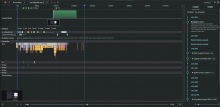We want to explore using a CSS-only solution for fixing user generated content using a CSS attribute contains query, but we have reservations around performance.
Conduct a performance impact assessment of applying a global CSS rule [style*=background] { color: #333; } to correct text color in night mode for all elements with a specified background style. This task involves setting up test scenarios to measure page rendering times, resource utilization, and overall user experience before and after applying the rule. Deliverables include a detailed report on findings, with analysis on whether the solution meets performance standards for deployment on Wikimedia projects.
Timebox
half a day
Outcome
An assessment of whether this is viable or not.

